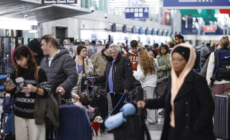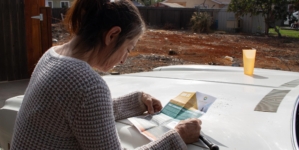-
Who Is Stephen Miran? What Trump Adviser Pick Has Said About the Economy - 26 mins ago
-
These Spiritual Democrats Urge Their Party to Take a Leap of Faith - 48 mins ago
-
Matt Gaetz Ethics Committee Report: What to Expect in Monday’s Release - about 1 hour ago
-
Visitors to Riverside’s Festival of Lights warned of parking scam - about 1 hour ago
-
Letter Calling for Tracking People of Color Circulates in an Oregon County - 2 hours ago
-
Eagles’ Jalen Hurts Officially Ruled Out With Concussion - 2 hours ago
-
Possible rain, high surf forecast for Los Angeles area in holiday week - 2 hours ago
-
Tiger Woods Son Charlie Hits Epic Hole in One While Playing Alongside Father - 2 hours ago
-
Trump Picks a Former Treasury Official as His Top Economist - 2 hours ago
-
Winter Weather: ‘Trouble Spots’ Across US as Millions Travel for Christmas - 3 hours ago
Daylight saving ends Sunday: Some tips as we head to the dark side
In the wee hours of Sunday morning, Californians will gain an hour of sleep, and in return, they’ll receive an entire winter season during which the sun sets before most people leave the office.
Yes, that’s right, daylight saving is ending and darkness is coming. At 2 a.m. Sunday, most clocks on phones and devices will automatically fall back an hour to 1 a.m., while clocks in cars and on stoves will probably need to be manually adjusted.
California and every other state with the exception of Alaska and Hawaii will remain on standard time until March 9, when the clocks “spring forward” an hour as daylight saving time returns.
Why do we change the clocks twice a year?
Daylight saving time was originally implemented by Congress in 1918 to help conserve fuel and power during World War II by adding a daytime hour. However, a 2008 study by the Energy Department showed that the time change had very little measurable effect on energy or gasoline consumption.
Still, some economists support daylight saving because the bonus sunlight has been credited with increasing consumer spending in the evening. For example, JPMorgan Chase found that daily credit and debit card spending goes up by 0.9% when daylight saving time starts and down by 3.5% when it ends.
Nevertheless, the twice-annual changing of the clocks is generally unpopular, with complaints including that it causes confusion, inconvenience, health risks, car crashes and sleep disruptions.
Indeed, Americans have been tussling over the time warp for well over a century now.
Congress actually reversed the change in 1920, just two years after it was first federally mandated. Then, in 1942, Congress made daylight saving time permanent year-round to conserve fuel during World War II. In 1945, that measure was repealed, and states were allowed to choose how they would observe daylight saving and standard time.
In 1986, Congress amended the law to begin daylight saving time on the first Sunday in April and end it on the last Sunday of October. Finally, the Energy Policy Act of 2005 tweaked the timing to make daylight saving time begin on the second Sunday of March and end on the first Sunday of November.
What are the pitfalls of the time shift?
The American Medical Assn. and the American Academy of Sleep Medicine are both in favor of eliminating the time changes and moving to standard time permanently, saying this would align best with people’s natural circadian rhythm and boost health outcomes.
“For far too long, we’ve changed our clocks in pursuit of daylight, while incurring public health and safety risks in the process. Committing to standard time has health benefits and allows us to end the biannual tug of war between our biological and alarm clocks,” said Dr. Alexander Ding, a trustee with the American Medical Assn., in a statement.
On the other hand, many politicians support making daylight saving time permanent and thereby keeping longer evenings year-round.
At least 20 states, including California, have passed laws or resolutions asking to make daylight saving time permanent since 2018, but it’s up to Congress to pass a bill making this an official policy.
In 2022, Sen. Marco Rubio (R-Fla.) and a bipartisan group of co-sponsors proposed the Sunshine Protection Act to extend daylight time year-round. The bill passed the Senate unanimously but died in the House. Rubio reintroduced the act in 2023, but it failed to move forward through either chamber and was not reintroduced in 2024.
A few tips for adjusting to the darker winter days
Typically, the “spring forward” in the springtime, with its accompanying lost hour of sleep, is harder on people’s bodies and has been linked to an uptick in heart attacks and strokes.
Nevertheless, this week’s “fall back” comes with its own challenges. Notably, losing an hour of daylight can take a toll on people who are susceptible to seasonal affective disorder, a type of depression that peaks during the darker winter months.
“Disruptions to normal sleep and wake patterns like those that occur when we turn our clocks back one hour can lead to dysregulation or a mismatch between external cues (daylight/darkness, timing of going to bed and rising in the morning) and our circadian clock,” UC San Diego health sciences professor Larry Palinkas explained in an email to The Times.
In turn, he said, that “can precipitate depressive episodes in such individuals.”
Taking melatonin supplements, eating a healthy diet and reducing alcohol intake before the time change and for a short period afterward can help to alleviate symptoms of sadness or depression, Palinkas said.
Saba Harouni Lurie, a Los Angeles-based therapist who has experience helping clients deal with seasonal affective disorder, told The Times her No. 1 piece of advice is to increase exposure to sunlight.
“One of the suspected causes of seasonal affective disorder is decreased serotonin production due to lowered exposure to sunlight,” she said. “Trying to get more sun each day is often the first step in managing the symptoms once you suspect that you’re suffering from seasonal affective disorder.”
For bonus points, Lurie suggests pairing sunlight exposure with exercise or socialization, both of which can help fight symptoms of depression.
And for people whose work schedules or lifestyles make it challenging to spend time in the sun, indoor light therapy lamps that mimic natural light have been shown to combat seasonal affective disorder.
Source link





















